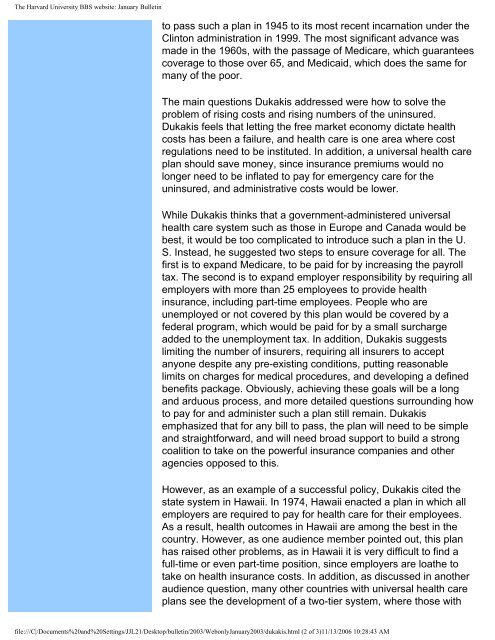January 2003 - Division of Medical Sciences Bulletin - Harvard ...
January 2003 - Division of Medical Sciences Bulletin - Harvard ...
January 2003 - Division of Medical Sciences Bulletin - Harvard ...
You also want an ePaper? Increase the reach of your titles
YUMPU automatically turns print PDFs into web optimized ePapers that Google loves.
The <strong>Harvard</strong> University BBS website: <strong>January</strong> <strong>Bulletin</strong><br />
to pass such a plan in 1945 to its most recent incarnation under the<br />
Clinton administration in 1999. The most significant advance was<br />
made in the 1960s, with the passage <strong>of</strong> Medicare, which guarantees<br />
coverage to those over 65, and Medicaid, which does the same for<br />
many <strong>of</strong> the poor.<br />
The main questions Dukakis addressed were how to solve the<br />
problem <strong>of</strong> rising costs and rising numbers <strong>of</strong> the uninsured.<br />
Dukakis feels that letting the free market economy dictate health<br />
costs has been a failure, and health care is one area where cost<br />
regulations need to be instituted. In addition, a universal health care<br />
plan should save money, since insurance premiums would no<br />
longer need to be inflated to pay for emergency care for the<br />
uninsured, and administrative costs would be lower.<br />
While Dukakis thinks that a government-administered universal<br />
health care system such as those in Europe and Canada would be<br />
best, it would be too complicated to introduce such a plan in the U.<br />
S. Instead, he suggested two steps to ensure coverage for all. The<br />
first is to expand Medicare, to be paid for by increasing the payroll<br />
tax. The second is to expand employer responsibility by requiring all<br />
employers with more than 25 employees to provide health<br />
insurance, including part-time employees. People who are<br />
unemployed or not covered by this plan would be covered by a<br />
federal program, which would be paid for by a small surcharge<br />
added to the unemployment tax. In addition, Dukakis suggests<br />
limiting the number <strong>of</strong> insurers, requiring all insurers to accept<br />
anyone despite any pre-existing conditions, putting reasonable<br />
limits on charges for medical procedures, and developing a defined<br />
benefits package. Obviously, achieving these goals will be a long<br />
and arduous process, and more detailed questions surrounding how<br />
to pay for and administer such a plan still remain. Dukakis<br />
emphasized that for any bill to pass, the plan will need to be simple<br />
and straightforward, and will need broad support to build a strong<br />
coalition to take on the powerful insurance companies and other<br />
agencies opposed to this.<br />
However, as an example <strong>of</strong> a successful policy, Dukakis cited the<br />
state system in Hawaii. In 1974, Hawaii enacted a plan in which all<br />
employers are required to pay for health care for their employees.<br />
As a result, health outcomes in Hawaii are among the best in the<br />
country. However, as one audience member pointed out, this plan<br />
has raised other problems, as in Hawaii it is very difficult to find a<br />
full-time or even part-time position, since employers are loathe to<br />
take on health insurance costs. In addition, as discussed in another<br />
audience question, many other countries with universal health care<br />
plans see the development <strong>of</strong> a two-tier system, where those with<br />
file:///C|/Documents%20and%20Settings/JJL21/Desktop/bulletin/<strong>2003</strong>/Webonly<strong>January</strong><strong>2003</strong>/dukakis.html (2 <strong>of</strong> 3)11/13/2006 10:28:43 AM




